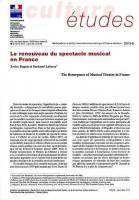Xavier DUPUIS, Bertrand LABARRE
november 2013
12 p.
From its inception in France at the end of the 20th century with the operetta, musical theatre came to captivate Anglo- Saxon audiences, to the extent that it has shaped the identity of certain areas of London (the West End) and New York (Broadway); meanwhile, the genre fell from favour with French audiences. The success of Starmania in 1979 and Notre- Dame-de-Paris in 1998 reignited the interest of creators, promoters and French audiences in musical theatre and towards the end of the 2000s, it began to top the ratings and play to packed houses.
There are three main types of musical theatre, corresponding to different artistic demands and each with their own discrete financial schemes and economic models: the French comédie musicale, which is similar to the variety show; musical theatre, whose economic model is similar to that for subsidised performing arts, and “Anglo-Saxon” style musical theatre, represented in France by the Mogador theatre where an industrial approach to live entertainment prevails.
However the genre has been promoted by certain theatres which have made their mark upon it and musicals have seen some spectacular popular success stories. Nevertheless, such activity in France remains fairly low at national level (less than 10% of total audiences for paying productions) and in comparison with such activity in the US, United Kingdom and even Germany.

![The Resurgence of Musical Theatre in France [CE-2013-6]](https://www.culture.gouv.fr/var/culture/storage/images/_aliases/reference/media/politiques-ministerielles/etudes-et-statistiques/images/culture-etudes/2013_en/vignette-ce-2013-6-_en/633209-1-fre-FR/Vignette-CE-2013-6-_EN.jpg)
